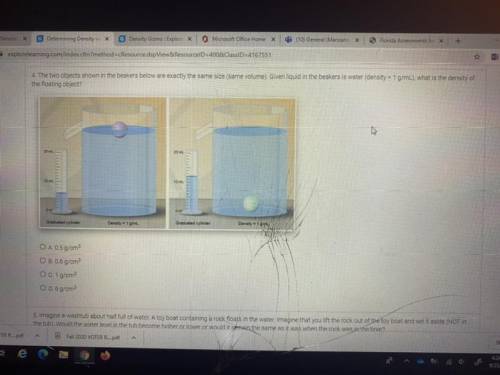
Physics, 05.10.2020 04:01 angelicahouston8727
The two objects shown in the beakers below are exactly the same size (same volume). Given liquid in the beakers is water (density = 1 g/mL), what is the density of the floating object?
A. 0,5g/cm^3
B. 0,6g/cm^3
C. 1g/cm^3
D. 6g/cm^3


Answers: 1


Another question on Physics

Physics, 21.06.2019 16:10
If two metal balls each have a charge of -10^-6 c and the repulsive force between them is 1 n, how far apart are they? (coulomb's constant is k = 9.0x 10^9 n-m^2/c^2? 9.5 m 9.0 mm 9.5 cm 0.9 m .
Answers: 3

Physics, 22.06.2019 00:40
Electroplating is a way to coat a complex metal object with a very thin (and hence inexpensive) layer of a precious metal, such as silver or gold. in essence the metal object is made the cathode of an electrolytic cell in which the precious metal cations are dissolved in aqueous solution. suppose a current of 480.ma is passed through an electroplating cell with an aqueous solution of agno3 in the cathode compartment for 46.0 seconds. calculate the mass of pure silver deposited on a metal object made into the cathode of the cell. round your answer to 3 significant digits. also, be sure your answer contains a unit symbol. ×10μ
Answers: 3

Physics, 22.06.2019 01:00
First, launch the video below. you will be asked to use your knowledge of physics to predict the outcome of an experiment. then, close the video window and answer the question at right. you can watch the video again at any point. part a as in the video, we apply a charge +q to the half-shell that carries the electroscope. this time, we also apply a charge –q to the other half-shell. when we bring the two halves together, we observe that the electroscope discharges, just as in the video. what does the electroscope needle do when you separate the two half-shells again? view available hint(s) as in the video, we apply a charge + to the half-shell that carries the electroscope. this time, we also apply a charge – to the other half-shell. when we bring the two halves together, we observe that the electroscope discharges, just as in the video. what does the electroscope needle do when you separate the two half-shells again? it deflects more than it did at the end of the video. it deflects the same amount as at end of the video. it does not deflect at all. it deflects less than it did at the end of the video. submit
Answers: 2

Physics, 22.06.2019 12:30
Consider a hydrogen atom in the ground state. what is the energy of its electron? =e= jj now consider an excited‑state hydrogen atom. what is the energy of the electron in the =5n=5 level? =e5= j
Answers: 3
You know the right answer?
The two objects shown in the beakers below are exactly the same size (same volume). Given liquid in...
Questions



Mathematics, 20.08.2019 14:00



Mathematics, 20.08.2019 14:00


Biology, 20.08.2019 14:00

Business, 20.08.2019 14:00



Mathematics, 20.08.2019 14:00

Mathematics, 20.08.2019 14:00





History, 20.08.2019 14:00


Mathematics, 20.08.2019 14:00



